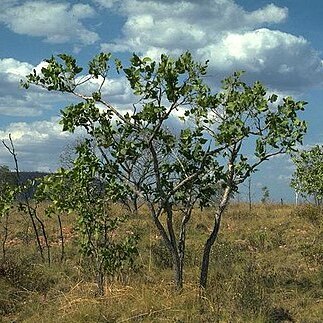Tree to 7 m tall. Forming a lignotuber.Bark rough to the small branches, thick, tessellated to flaky, grey to grey-brown over red-brown.Branchlets lack oil glands in the pith; smooth (glabrous), silvery to greenish, not glaucous.Juvenile growth (coppice or field seedlings to 50 cm): stems rounded in cross-section, smooth; juvenile leaves opposite, sessile, cordate, large, 15–23 cm long, 8–15 cm wide, stem-clasping, green, more or less smooth, sometimes a few scattered bristle-glands bearing simple hairs can be found on the lamina. Crown of stiff, juvenile leaves, opposite, sessile or on very short petioles (0–0.5 cm); blade cordate to broadly lanceolate, 7–23.5 cm long, 3–11 cm wide, undulate, base usually amplexicaul or lobed, rarely rounded, margin entire, apex pointed, concolorous or slightly discolorous, dull, green but yellowish near main veins, glabrous (rarely a few sparse bristle-glands at the base of the lamina), side-veins at a wide angle to the midrib and widely spaced, and looping to form intramarginal vein, reticulation very dense, oil glands apparently absent.Inflorescence usually terminal compound although somewhat congested and with very few branches, sometimes reduced to solitary axillary umbels, the inflorescence internodes and peduncles scabrid with ferrugineous setae (bristle-glands) when first formed but soon becoming smooth, peduncles stout, rounded to angular, ultimately smooth, 0.3–1.8(2.5) cm long; umbels of usually 7, rarely 9 or 11 buds per umbel, sessile or on pedicels to 0.3 cm long. Mature buds obovoid to pyriform (1.1–1.6 cm long, 0.9–1.2 cm wide when mature), reddish and smooth, scar absent (both opercula shed together at flowering), operculum rounded, stamens inflexed, all fertile, anthers versatile, dorsifixed, oblong, dehiscing by longitudinal slits, style long and straight, stigma blunt and ?papillose, locules 4, with ca 7 or 8 vertical ovule rows on the placentae, or the rows indistinct. Flowers creamy white.Fruit sessile or pedicellate (pedicels to 0.5 cm long), urceolate with a conspicuous erect neck, 2–3.5 cm long, 1.7–3 cm wide, longer than wide, surface smooth, disc descending vertically, valves 4, enclosed.Seeds brown, 10–16 mm long, ellipsoidal with terminal wing, hilum ventral. Cultivated seedlings (measured at ca node 10): cotyledons large, reniform; stems rounded in cross-section, setose with bristle-glands bearing short simple hairs; leaves opposite, sessile to very shortly petiolate (petioles to 0.3 cm), ovate to elliptical, 4–9.5 cm long, 2–5 cm wide, base rounded or tapering to petiole, becoming stem-clasping higher up the stem, apex rounded or pointed, mid-green, ± concolorous, setose on both sides with bristle-glands bearing short simple hairs.
More
Tree to 6 m, scraggy. Bark flaky or irregularly tessellated throughout, grey or grey-brown to yellow-brown. Juvenile leaves broadly lanceolate, 6–9 cm long, 2–3 cm wide, white stellate-hairy. Leaves on mature trees opposite, sessile or petiolate, narrowly ovate, lanceolate or oblong-lanceolate, thick; lamina 7–16 cm long, 3–8 cm wide, acute or acuminate, cordate or amplexicaul, sparsely hispid, yellow-green, concolorous; lateral veins at 50°–65°; intramarginal vein irregular, usually close to margin; petiole absent or up to 5 mm long. Umbels 3–7-flowered; peduncle thick, 15–25 mm long, bristly when young; pedicels absent or up to 3 mm long. Buds clavate, pyriform or obovoid; operculum patelliform, c. 2 mm long, 5–7 mm wide; hypanthium obconical or suburceolate, 8–10 mm long, 7–8 mm wide. Fruits sessile or shortly pedicellate, globular to urceolate, 2–3 cm long, 1.7–2.5 cm wide. Seeds winged at one end, yellow-brown.


